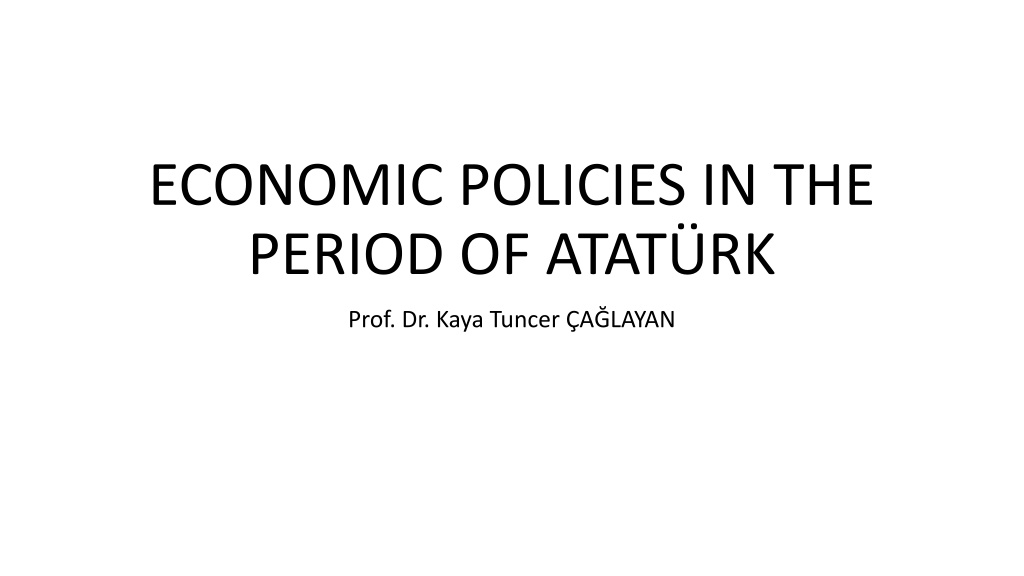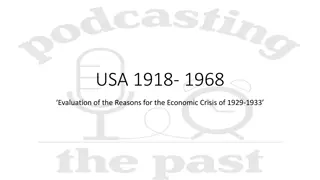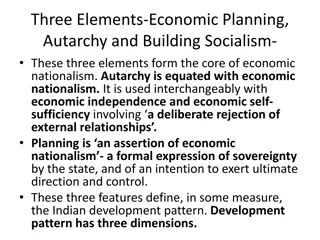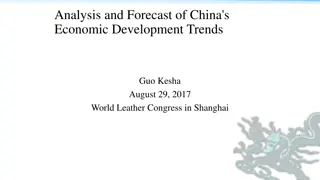ECONOMIC POLICIES IN THE PERIOD OF ATATURK
This content delves into the economic policies during Atatürk's era, focusing on the Liberal Period (1923-1932) and Statism Period (1932-1939). It covers significant events like the Izmir Economic Congress, Treaty of Lausanne, and the shift towards statism with the First Five-Year Industrial Plan. The Congress agenda, decisions, and major economic issues addressed in the Treaty of Lausanne are highlighted.
Uploaded on Mar 05, 2025 | 0 Views
Download Presentation

Please find below an Image/Link to download the presentation.
The content on the website is provided AS IS for your information and personal use only. It may not be sold, licensed, or shared on other websites without obtaining consent from the author.If you encounter any issues during the download, it is possible that the publisher has removed the file from their server.
You are allowed to download the files provided on this website for personal or commercial use, subject to the condition that they are used lawfully. All files are the property of their respective owners.
The content on the website is provided AS IS for your information and personal use only. It may not be sold, licensed, or shared on other websites without obtaining consent from the author.
E N D
Presentation Transcript
ECONOMIC POLICIES IN THE PERIOD OF ATAT RK Prof. Dr. Kaya Tuncer A LAYAN
ECONOMIC POLICIES IN THE PERIOD OF ATATRK Liberal Period (1923-1932) Izmir Economic Congress (17 February-4 March 1923) Lausanne Treaty (July 24, 1923) Abolition Of Excise Duty (7 February 1925) Encouragement of the industry Law (28 October 1927) Established Banks Great World Depression (October 24, 1929))
Statism Period (1932-1939) First Five-Year Industrial Plan (1934-1939) Government Institutions in this period Atat rk's Policy Of Statism
Izmir Economic Congress (17 February-4 March 1923) Kaz m Karabekir Pasha chaired. 1135 representatives of farmers, traders, industrialists and workers attended. The aim is to ensure that the economic factors and units exhausted from the war get to know each other, to identify their needs, to draw attention to economic issues and to determine economic policies accordingly.
Congress agenda; regulation of credit, production and consumptioncustoms, company and trade unions road and transport vehicles, the situation of the villagers were main titles.
Decisions Taken In Congress were Legislation to promote industry Changing customs tariffs according to the needs of the national industry Cheap transportation of domestic goods on land and at sea Establishment of banks that will provide suitable credit facilities for the industry Development of technical education Monitoring of the Budget Policy and not exceeding exports of imports
TREATY OF LAUSANNE 24 July 1923 Major economic issues in the treaty were Removal of capitulations Privileges granted to foreigners Ottoman debts Customs regulations War damage Population change and
Problem of Musul These provisions in the treaty prevented Turkey from pursuing an effective foreign trade policy until 1929.
ABOLITION OF EXCISE DUTY 7 February 1925 During the Ottoman period, it was taxed from the peasant for agricultural products produced. With the abolition of excise tax, the tax burden has been shifted from rural to market and to the city. While excise tax is charged as manufactured goods, subsequent taxes are taken in cash.
INDUSTRIAL PROTECTION LAW 28 OCTOBER 1927 The Republic s first comprehensive incentive law. It granted exemption and privileges to private industrial enterprises and Mining Enterprises. State institutions, municipalities, private administrations were obliged to take the property of enterprises benefiting from this law, even though it is more expensive than imported goods. This law was stipulated to remain in force for fifteen years.
ESTABLISHED BANKS I Bank (26 July 1924) This is the first bank established in this period. It was established as a national financing institution in order to prevent the negative effects of foreign banks. Celal Bayar was the first general manager of the bank. INDUSTRY AND MINES BANK established to contribute to the establishment of industrial enterprises. The Ottoman-era enterprises are obliged to transfer private enterprises and to work in partnership with private capital. The bank was seen as a goal of the struggle of the state to raise the bourgeoisie.
AGRICULTURAL BANK Founded in the Ottoman period with national capital, it is an important bank that continues its activities in the Republican period. 1 March 1923, Ziraat Bank code was executed before in the Grand National Assembly in his speech Mustafa Kemal Ataturk said: "Agricultural Bank branches and crates, which are responsible for helping the workers in agriculture, were only one hundred ten until four months ago, and these days have been increased to more than three hundred. In the last two months, nearly two million liras of capital has been provided to this bank and the bank has started to lend a large amount of money to the country which has been rescued from the enemy.
The bank's position and impact in our economic lives will increase when the draft law, which is prepared to include important issues such as the use of borrowing in production, the good form of the bank's Board of directors and the use of personal reputation transactions, is enacted. A village banks law has been enacted to provide a loan institution to our villagers and to provide a financial reputation for the income they will earn from their fields in determining the amount of borrowing to the soldiers who will return to their fields if the stability of the people is ensured on this issue. So the draft passed easily.
Central bank (11 June 1930) With the establishment and operation of the Central Bank, the economic order in the country has become easier to protect itself. As a result, the implementation of the monetary and capital markets in the Ottoman Bank and minority countries against our national economic interests has been put to an end. REAL ESTATE AND EYTAM BANK (3 June 1926) It was established to support construction enterprises and to provide the necessary credits.
In the 1923-1929 period, an industrialization policy based on private enterprise was adopted and it was expected that industrialization and development would be realized thanks to the efforts of the private enterprise. However, at the end of the implementation, the results were found to be behind the expectations of the management staff. The government was therefore not satisfied with the pace and structure of industrialization carried out by private entrepreneurs during that period.
Opened Factories Bak rk y Cloth Factory 1934 Ke iborlu Sulphur Factory 1934 Kayseri Cloth Factory 1935 Pa abah e Glass Factory 1935 Zonguldak Turkish Anthracite Factory 1935 Izmit First Paper Factory 1936 Bar Dam 1936Nazilli Printing Factory 1937 Eregli Cloth Factory 1937 Gemlik Artificial Silk Factory 1938 Bursa Merinos Factory 1938 Divri i Iron Mine Factory 1938
Opened Institutions Directorate General Of Public Administration 1930 General Directorate Of Monopoly 1931 General Directorate of PTT 1933 Airlines Management 1933 General Directorate Of Sugar Factories Of Turkey 1935 Mining Research Institute 1935 Electrical Works Survey Administration 1935 Land Registry Directorate 1936 General Directorate Of State Meteorological Affairs 1937
The Republic of Turkey, which has been searching for a state-owned industrialization model with the impact of the Great world crisis of 1929, has carried out a planned industrialization process in line with the industrial plans, which was considered as one of the first planning experiences in the world during this period.
State-owned industrialization is not an industrial type industrialization that produces industrial products targeting investment goods but an import substitution industrialization model for basic consumption and intermediate goods production. The studies that started with the report on our economic situation of 1930 came to life with the technical and financial assistance of the USSR. Then, using the reports of American experts in 1934 in industry planned period was started.
It is possible to say that the following factors are effective in shaping the statistic economic policies pursued in Turkey in the 1930s: 1. Failure to achieve the desired result from liberal economic policies pursued between 1923-1929, 2.1929 the Great Depression of the world affected all economies on a world scale negatively,
3. Success of the first results of planned economic policies implemented in the USSR, 4. Classical economic policies could not produce a solution to the 1929 crisis on the state's intervention in the economy to gain popularity advocating views.
The Effects Of 1929 The Great World Crisis On Turkish Economy The Great Depression of the world in 1929 had been the biggest crisis of economic systems since the emergence of capitalism. The impact of the Great World Crisis on the Turkish economy started with a decline in the value of money, and the decline in the prices of export goods showed a decline.
The constant decline in foreign trade rates was reflected at a higher level in domestic trade rates, and the price decline in agricultural products was more than in industrial products prices. This led to a decline in agricultural production, resulting in a decline in the Turkish economy, in which the opening to the market and the transition to the monetary economy were limited.
TURKEY'S NEGATIVE IMPACT HAd BEEN LIGHTER THAN OTHER COUNTRIES. 1. The relative low level of Turkish economy's integration into the world economy 2. exports not only rely on agricultural products, but also on various sectors. 3. Turkey had a self-sufficient economy.
MEASURES AGAINST THE GREAT WORLD CRISIS 1. Balance public expenditures in accordance with public revenues 2. By introducing restrictions on imports, ensuring that foreign trade is not open and not overpaid The effects of Free Trade imposed on the economy in Turkey in the 1934 report of the Ministry of interior were as follows::
During the period when customs gates were kept open, silk fabrics imported from Europe caused Bilecik Dutluk to be unfunctional. In 1821, there were 600 hand looms left only 40 in sk dar. In the same way, the number of countertops decreased to 1000 in T rnova, which had 3000 countertops in 1812. The collapse of the weaving industry also affected other industries. There was almost no hope that the industry would be revived one day in the country.
FIRST FIVE-YEAR INDUSTRIAL PLAN State industrialization started with the first five-year industrial plan, which was put into effect in 1934 in line with the industrialization program prepared in 1933. The first five-year industrial plan included only the industrial sector and not the agriculture and services sector. Considering that the share of the industrial sector in GNP was 15% in the 1930s, 85% of the economy was out of the plan.
THE MAIN OBJECTIVES OF THE FIRST FIVE-YEAR INDUSTRIAL PLAN 1.Main raw materials are grown in the country or in a short time possible to be able to handle the industry branches. 2. These factories to be established are factories that need great capital and technical power, so they should be left to the state or national institutions. 3. The production capacity of the factories that are planned to be established is proportional to the needs and consumption.
The first five-year industrial plan envisaged to be established and realized largely in the five main groups of the industry were gathered. These are, respectively, 1. The Weaving Sector (Cotton, Hemp, Wool) 2. Mining Sector (Iron-Steel, Sulfur, Copper) 3. Paper Sector (Cellulose) 4. Chemical Industry (Artificial Silk, Phosphoric Acid, Super Phosphate, Lime Cream, Posata, Match) 5. Stone-Earth Sector (Glass, Cement, Bottle, Ceramic)
The establishment of 20 factories in industrial branches and investment of 43.543.000 TL for these factories were foreseen. The financing required for these factories was met by S merbank and I Bank. The basic source of Finance has created taxes on consumer goods.
THE SECOND FIVE YEAR DEVELOPMENT PLAN After 1936, preparations for the second five-year industrial plan were initiated before the first five-year industrial plan expired. Although his illnes, Mustafa Kemal Atat rk carried out the preparation of the second industrial development plans covering 1938-1942, one year before his death, by taking the prime minister and other officials to his side. He called the Prime Minister Celal Bayar to Dolmabah e Palace and ordered the completion of the investments, the realization of the investments in the second stage and the further development of the railways.
The second five-year industrial plan gave priority to the production of intermediate goods and investment goods. Infrastructural developments such as electrification, mining and ports were taken into consideration. It can be said that the second five-year industrial plan attached importance to the principle of self-sufficiency and that the first plan s natural extension. However, the second five-year industrial plan, was not implemented because of World War II.























